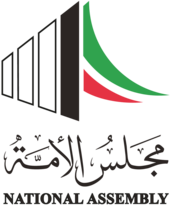| National Assembly of Kuwait مجلس الأمة الكويتي Majlis al-ʾUmma al-Kuwaytiyy | |
|---|---|
 Logo used to represent the National Assembly Logo used to represent the National Assembly | |
| Type | |
| Type | Unicameral |
| Term limits | None |
| Leadership | |
| Emir of Kuwait | Mishal Al-Ahmad Al-Jaber Al-Sabah since 16 December 2023 |
| Structure | |
| Seats | 50 elected members Up to 16 appointed members |
| Length of term | Four years |
| Elections | |
| Voting system | Single non-transferable vote |
| Last election | April 4, 2024 |
| Meeting place | |
| Kuwait National Assembly Building, Kuwait City, Kuwait 29°22′13″N 47°57′50″E / 29.37028°N 47.96389°E / 29.37028; 47.96389 | |
| Website | |
| kna | |
| Politics of Kuwait |
|---|
 |
|
|
| Constitution |
| Monarchy |
| Government |
| Judiciary |
| Administration |
|
Foreign relations
|
| Related topics |
|
|
The National Assembly (Arabic: مجلس الأمة) is the unicameral legislature of Kuwait. The National Assembly met in Kuwait City. The National Assembly is made up of 50 elected members and 16 directly appointed government ministers (ex officio members).
The assembly was frequently dissolved by the Emir of Kuwait. From 2006 to 2024, the assembly was dissolved 13 times. The assembly has been suspended since 10 May 2024 for a four-year constitutional re-evaluation due to frequent inaction, corruption, bribery, vote purchasing and political deadlock.
Overview
The National Assembly is the legislature in Kuwait, established in 1963. Its predecessor, the 1938 National Assembly, was formally dissolved in 1939 after "one member, Sulaiman al-Adasani, in possession of a letter, signed by other Assembly members, addressed to Iraq's King Ghazi, requesting Kuwait's immediate incorporation into Iraq." This demand came after the merchant members of the Assembly attempted to extract oil money from Ahmad Al-Jaber Al-Sabah, a suggestion refused by him and upon which he instigated a crackdown which arrested the Assembly members in 1939.
The National Assembly normally consists of 65 members; this total includes 50 elected deputies as well as 15 cabinet members directly appointed by the Emir. Fifty deputies are elected by one non-transferable vote to serve four-year terms. Members of the cabinet also sit in the parliament as deputies. The constitution limits the size of the cabinet to 16. The cabinet ministers have the same rights as the elected MPs, with the following two exceptions: they do not participate in the work of committees, and they cannot vote when an interpolation leads to a no-confidence vote against one of the cabinet members. As per Article 107 of the Kuwait constitution, the National Assembly can be dissolved by the Emir by decree, giving the reasons for the dissolution. However, the National Assembly shall not be dissolved again on the same grounds, and elections for the new Assembly must be held within a period not exceeding two months from the date of the dissolution.
In contrast to parliaments in other Gulf kingdoms, the Kuwaiti assembly has considerably more formal and informal power than elsewhere in the region.
The assembly was previously suspended from 1976-1981 and 1986-1991.
Gender balance
Kuwaiti women gained the right to vote in 2005. Women first won seats in the National Assembly in the 2009 election, in which four women, Aseel al-Awadhi, Rola Dashti, Massouma al-Mubarak and Salwa al-Jassar, were elected.
Building
Main article: Kuwait National Assembly BuildingThe parliament building was designed by Danish architect Jørn Utzon, who also designed the Sydney Opera House.
Political factions
While political parties are not legal in Kuwait, a number of political factions existed. The house is composed of different political factions:
- The liberal bloc.
- The Shaabi (populist) bloc: A coalition of populists (Sunni and Shia), liberals and nationalist political organizations with a focus on middle-class issues. The Popular Action Bloc is their main political organization.
- The Islamist bloc: Consisting of Sunni Islamist members.
Kuwait's 2024 elections witnessed an increase in voter turnout.
See also
- Politics of Kuwait
- Government of Kuwait
- Cabinet of Kuwait
- Elections in Kuwait
- List of Shia members of the National Assembly of Kuwait
- List of speakers of Kuwait National Assembly
- Kuwait National Assembly No-Confidence Votes
- List of political parties in Kuwait
References
- Gandhi, Jennifer (26 July 2010), "Institutions and Policies under Dictatorship", Political Institutions under Dictatorship, Cambridge: Cambridge University Press, pp. 10–240, ISBN 978-0-511-51009-0, retrieved 2020-11-16
- ^ Yom, Sean (2024). "Will Kuwait's Next Parliament Be Its Last?". Journal of Democracy.
- "ما أسباب تأجيل انعقاد مجلس الأمة الكويتي؟". الجزيرة.
- Herb, Michael (2014). The wages of oil : Parliaments and economic development in Kuwait and the UAE. Ithaca. ISBN 978-0-8014-5469-1. OCLC 897815115.
{{cite book}}: CS1 maint: location missing publisher (link) - Crystal, Jill (27 January 1995). "3. Kuwait on the eve of oil" (Paperback). Oil and Politics in the Gulf: Rulers and Merchants in Kuwait and Qatar (Updated ed.). Cambridge University Press. p. 50. ISBN 9780521466356. Retrieved 14 April 2023.
- "Kuwait: Majles Al-Ommah (National Assembly)". archive.ipu.org. Inter-Parliamentary Union. Retrieved 20 May 2024.
- "Constitution of the State of Kuwait 1962, as amended to 2012". constitutions.unwomen.org. Retrieved 2021-09-02.
- Omar, Faten (2024-04-05). "High voter turnout highlights increasing awareness". kuwaittimes. Retrieved 2024-05-30.
| Kuwait articles | |||
|---|---|---|---|
| History |  | ||
| Geography | |||
| Politics | |||
| Economy | |||
| Culture | |||
| National unicameral legislatures | |
|---|---|
| Federal | |
| Unitary |
|
| Dependent and other territories |
|
| Non-UN states | |
| Historical | |
| Related | |